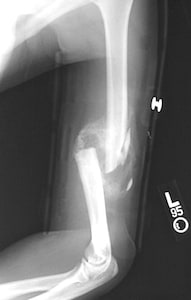T or Y Fracture of the Humerus
T or Y Fracture of the Humerus
 The elbow is an important structure in the body where the humerus, radius, and ulna meet. The intersection of these bones forms the elbow, an integral hinge joint that provides important function. Sometimes, patients can develop fractures in this joint. One such fracture is a T or Y fracture of the humerus, also called an intercondylar fracture.
The elbow is an important structure in the body where the humerus, radius, and ulna meet. The intersection of these bones forms the elbow, an integral hinge joint that provides important function. Sometimes, patients can develop fractures in this joint. One such fracture is a T or Y fracture of the humerus, also called an intercondylar fracture.
The humerus is the thick bone that makes up the upper part of the arm. The humerus travels down and connects to the elbow. At this site, there are thickened projections called condyles that help to increase the surface area of the bone where it articulates with the elbow. A fracture in these condyles, in contrast to a humerus shaft fracture, can split into three separate fragments, giving this fracture the name T or Y fracture as a description of the injury.
How do People Sustain this Fracture?The majority of intercondylar fractures develop when people extend their arms to protect against chest trauma. When people feel an impending impact coming, either from a fall or due to a traffic accident, they will extend their arms to protect themselves. While this will protect the vital organs, the force of the impact strikes the hands and travels up the arm. This could potentially lead to an intercondylar fracture.
Treatment OptionsBecause the bone splits into three pieces, the physician will need an x-ray to take a look at the fragments and figure out where they’re located. Then, the physician will need to make a decision regarding whether or not surgery is required.
Possible Complications a T or Y Fracture of the HumerusBecause this fracture splits into three separate pieces, there is the potential for complications. Most of the complications arise due to open fractures, or fractures that break the surface of the skin. These fragments can separate and cause damage to nerves and blood vessels, leading to major bleeding risks and possible infections. Whether it’s an infection, bleeding, or nerve damage, this can extend a hospital stay and drive up healthcare costs.
Other Structures may be DamagedThe splitting of the bone into three pieces creates the potential for nerves and blood vessels to be severed. If nerves are damaged, patients could suffer from neuropathic pain that can be extremely debilitating and hamper patients’ quality of life. Examples of nerves that could be damaged include the median nerve, the radial nerve, and the ulnar nerve.
Differential DiagnosisWith a T or Y fracture, other injuries on the differential diagnosis include:
- Elbow Bursitis
- Humerus Shaft Fracture
- Medial Epicondyle Fracture
- Lateral Epicondyle Fracture
- Elbow Dislocation
Most intercondylar fractures will require plates and screws to put the bone back together. With the bone splitting into three pieces, it is unusual to have the fragments sitting in perfect position to heal. While most patients will heal with the proper treatment, there is always the risk that patients could have chronic pain. For this reason, cases are handled on an individual basis.
Surgery May be NeededAlmost every fracture in this scenario will require surgery to place the three separate bones in proper position. If imaging reveals bones that are out of place, surgery is required.
Contact an Experienced Bone Fracture AttorneyI’m Ed Smith, a Sacramento Bone Fracture Attorney. Patients suffering from this dangerous fracture should call me at 916.921.6400 for friendly, free advice.
I am a member of the California Million Dollar Advocates Forum. We are some of the top trial lawyers in the United States and have won multiple million dollar decisions in prior cases.
Please spend some time going through my prior verdicts and settlements.
Past customers have left helpful reviews on Avvo, Yelp, and Google.
Image Attribution: Bill Rhodes via Wikimedia Commons
:dr bw [cs 664]